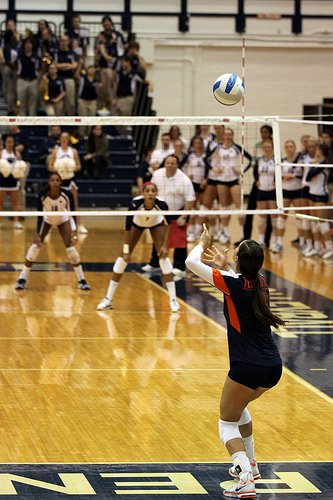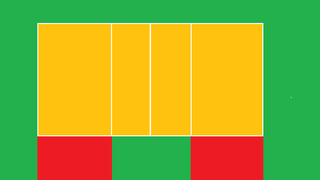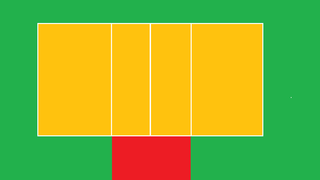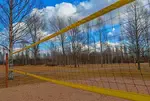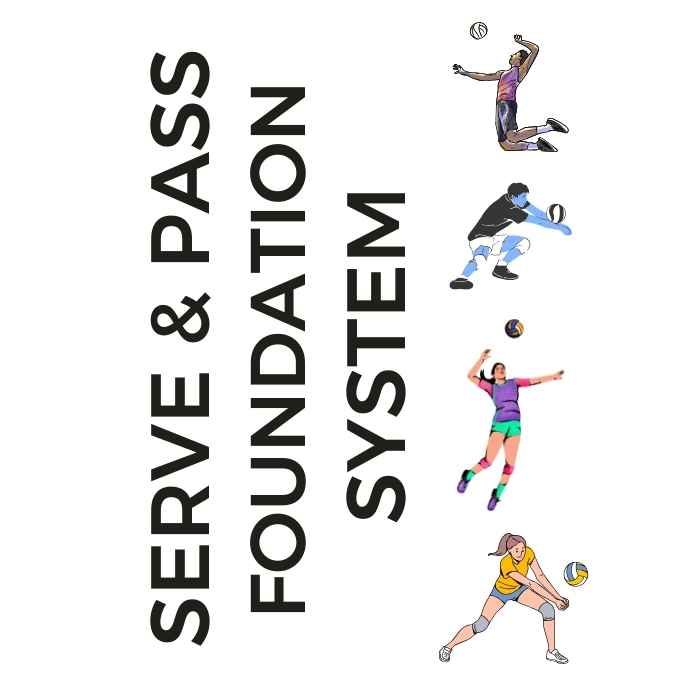
Serve + Pass Foundation System: The Complete Skills Arsenal The two-skill mastery system that transforms inconsistent players into the athletes coaches build their lineups around. Stop Struggling With The Two Most Important Skills In Volleyball!
- Improve Your Volleyball with Coach April
- Volleyball Court Size
- Volleyball Court Measurements
Volleyball Court Measurements, Zones and Playing Areas on the Court
Learn the volleyball court measurements like the length and width of the court, the height and length of the net and learn the zones on the volleyball court.
Welcome to my comprehensive guide on volleyball court measurements!
Whether you're a beginner looking to learn the basics or an experienced player seeking a refresher, understanding the dimensions of a volleyball court is necessary in order to build your game IQ.
In this guide, I will explore everything from the full court and half court measurements to the height of the net and the various zones on the court.
Setting up your own practice space?
These portable volleyball court boundary lines make it easy to practice anywhere.
So, let's get started and explore the essential measurements that make up this dynamic and exciting sport!
You'll gain a clear understanding of the official standards and regulations that govern the size and layout of a volleyball court.
Full Volleyball Court Measurements
 These measurements are for both men's and women's courts and is usually rounded up to 60 feet long by 30 feet wide.
(volleyball court diagram photo by kyle campbell)
These measurements are for both men's and women's courts and is usually rounded up to 60 feet long by 30 feet wide.
(volleyball court diagram photo by kyle campbell)The playing surface area for two team's competing against each other is called the full court and the official full volleyball court measurements are 59 feet by 29 feet by 6 inches.
These measurements are for both men's and women's courts and is usually rounded up to 60 feet long by 30 feet wide.
Half Volleyball Court Measurements
The half volleyball court measurements for both men's and women's courts is often rounded up to 30 feet long by 30 feet wide.
I played in Italy where professional volleyball is the second most popular sport.
In Europe, where the metric system is used the volleyball court measurements are 9 meters wide by 9 meters long for half court and 18 meters long by 9 meters wide.
For international, collegiate or club volleyball competition regardless of where you play and on what net height you practice and/or compete the volleyball court size does not change.
Regulation court dimensions for high school differ slightly.
The length of the full court and the width of the full court are all the same size and they always stay the same. Only the net heights change depending on the discipline.
Setting up your own practice space?
This volleyball court equipment should make it easy to practice anywhere.
What are the 6 court zones
located on the court?
There are 6 specific volleyball zones on the court which most players learn about first.
These 6 zones are rotational positions on the court that
- players rotate in and out of when their teams win a rally and the right to serve
These same zones are also called serving zones that
These 6 zones on the volleyball court are called
- Zone 1 located in Right Back - is also called RB or P1, Position 1
- Zone 2 located Right Front - is also called RF or P2, Position 2
- Zone 3 located Middle Front - is also called MF or P3, Position 3
- Zone 4 located Left Front - is called LF or P4, Position 4
- Zone 5 located Left Back - is called LB or P5, Position 5
- Zone 6 located Middle Back - is called MB or P6, Position 6
Volleyball Court Measurements
The Service Zone
Where is the service zone?
The service zone is where players serve the ball from at the beginning of each rally and it's located just beyond the endlines on each half of the court.
The volleyball court measurements for the service zones are 29 feet by 6 inches wide which is the same as the width of the court and it extends to six feet deep behind the endline.
There are two lines that serve as extensions to the sidelines that connect the furthest end of the service line to the court endline.
The service zone extends to the end of the free zone.
Volleyball Court Measurements
The History of the Service Zone
In recent years, the service zone which was limited to outside of the court behind the endline in zone 1, was increased to include the area outside of the court behind the entire endline from one sideline to the other.
So in the picture of the VCU volleyball player above, even though she chose to serve the ball from the "traditional" right back service area which is located just behind zone 1, outside of the endline, she was free to move further to her left to attempt the same serve anywhere from behind that white endline as long as she didn't step on it or over it before contacting the ball.
This means that the serving rules state that when serving the ball, players must still remain outside of the court before contacting the ball, but they can now step further to their left and go anywhere along their end line as long as they stay within the volleyball court sidelines.
Players are now allowed to move behind zone 6 which is middle back or even further left to behind zone 5 which is the left back area of the court (like the Penn State volleyball player in the picture above), to serve the ball, as long as they don't step on or over the line before they contact the ball.
Volleyball Court Measurements
What Happens in the Service Zone?
After the first referee blows their whistle, the server has eight (8) seconds to serve the ball into the opposing court which they have to initiate from behind the service line, inside the service zone, which is indicated in red in the diagram above.
There's six feet of space allotted to those who need runway takeoff space for their jump serve or jump float serve after the referee whistles for the beginning of the rally.
Volleyball Court Measurements
The Free Zone
The free zone is marked by a limited amount of space that is outside of the court boundary lines.
The volleyball court measurements are six (6) feet wide and is used as the area where the ball can be kept in play and where players are substituted in and out of the game.
Volleyball Court Measurements
The Replacement Zones
The libero has a special place of their own when they enter the game.
The replacement zone on an indoor volleyball court is where the libero comes in to take the place of the front row hitter she is going to play in the back row for.
The libero doesn't have to wait to enter the game, they can go right in as long as they enter in and out of the areas marked in red on the indoor volleyball court diagram above.
Volleyball Court Measurements
The Substitution Zone
This area is designated to players who are coming in to substitute a teammate during a game.
The red zone on the indoor court diagram indicates where the substitution zone is located.
Along the sidelines, the substitution zone is located between the attack line and the centerline and is where the player coming from the bench and the player coming off the court have to pause and wait until the referee acknowledges that the substitution can be made.
Now that you know where the court lines are, learn how to efficiently serve receive within those boundaries with my serve receive strategy checklist
Frequently Asked Questions about Volleyball Court Measurements
Q: What is the standard size of a volleyball court?
A: The standard size of a volleyball court is 59 feet by 29 feet and 6 inches for a full court, and 29 feet 6 inches by 29 feet 6 inches for a half court.
Q: Are the court measurements the same for both men's and women's volleyball?
A: Yes, the court measurements are the same for both men's and women's volleyball. The dimensions of the court do not differ based on gender.
Q: What are the dimensions of the net in volleyball?
A: The height of the net is 7 feet 4 1/8 inches (2.24 meters) for women's volleyball and 7 feet 11 5/8 inches (2.43 meters) for men's volleyball.
Q: How wide are the sidelines of a volleyball court?
A: The sidelines of a volleyball court are not officially specified. However, they are typically around 10 feet wide.
Q: Where is the center line located on a volleyball court?
A: The center line runs perpendicular to the net and divides the court into two equal halves. It extends from one sideline to the other.
Q: What is the attack line in volleyball?
A: The attack line, also known as the ten-foot line, is located 10 feet away from the centerline on both sides of the court. It separates the front row players from the back row players.
Q: How deep is the service zone in volleyball?
A: The service zone extends 6 feet behind the endline on each half of the court. It is the area from where the server serves the ball.
Q: Is there a specific measurement for the free zone in volleyball?
A: Yes, the free zone is the area surrounding the outside of the court. It has a minimum width of 6 feet 6 inches or 2 meters.
Q: Are there any regulations for the height of the ceiling above a volleyball court?
A: Yes, the ceiling should be free of any obstructions within a height of 23 feet above the playing area to ensure unrestricted play.
Q: Can the dimensions of a volleyball court vary at different levels of play?
A: The official dimensions of a volleyball court remain the same across all levels of play. However, non-regulation or recreational settings may have variations in court size.
Remember, if you have any specific questions or need further clarification about volleyball court measurements, feel free to ask!
Volleyball Court Line Systems COMPARISON CHART
Detailed Feature Breakdown
Installation Requirements:
- Permanent: Professional installation recommended - - Portable: 1-2 person setup - Training: Single person setup
Maintenance Needs:
- Permanent: Annual inspection/touch-up
- Portable: Monthly checking of straps/anchors
- Training: Regular cleaning/replacement
Surface Compatibility:
- Permanent: Wood, Sport Court
- Portable: All surfaces
- Training: Any flat surface
Investment Value:
- Permanent: Best long-term value
- Portable: Best versatility value
- Training: Best entry-level value
Volleyball Court:
Where Do You Go From Here?
Good times! Where do you need to go now? Here are three options:
- Learn more about the Court Size.
- Follow the suggested reading on our Sitemap page Learning How To Play (Sitemap)
- Or visit the pages in the Volleyball Rules section in the drop down menu at the top of the page.
If your athlete struggles with consistent serve receive, gets subbed out, or is overlooked for playing time—this is the fix you’ve been looking for.

Struggling with passing consistency?
I help talented passers tired of getting pulled from games because of inconsistent serve receive skills BUILD passing confidence without expensive private lessons using the same 3-step system that's helped dozens of my athletes get recruited.
Download my eBook for $17.99 and start building the passing confidence that keeps you on the court—and gets you seen by college coaches.
From Lady Vol to Legend: Coach April Produces Powerful Passionate Players...is that you?
What Are You Looking For?
Click to Download Your Pre Serving Ritual Mastery Checklist pdf:
🎯Volleyball Pre Serving Ritual Guide -
Players! Learn How To Transform Your Serve from Weak to Weapon
Click to Download Your Parent's Volleyball Serving Checklist pdf
🎯Parent's Volleyball Serving Checklist Guide
Parents! Help Your Player Develop Championship Serves (Even If You've Never Played)

Hi there!
Thanks for stopping by. Hope you learned something today that will help you reach your volleyball goals.
Be sure to subscribe to my email newsletter so you can learn more each week!
Stay strong! Stay motivated!
-Coach April

SUSCRIBE to my email newsletter below!
 Click to learn more about the weekly volleyball classes and clinics or email info@imrpoveyourvolley.com for information
Click to learn more about the weekly volleyball classes and clinics or email info@imrpoveyourvolley.com for informationCongratulations to my seven Boys-18s Vegas Volley club players who played in two state championship finals yesterday, the 3A and 5A State champinship finals at Sunrise Mountain High School.
TOURNAMENT CHAMPIONS!
A-1 Vegas Volley VBC
In It To Win It Tournament
May 2 - 4, 2025 Tournament
Gold Medalists
18s Premier Division
Vegas Volleyball's Unsung Heroes: Celebrating Moms with Peace Love Volleyball Shirts
Ready to energize your volleyball mom journey?
Subscribe to my 'Producing Powerful Passionate Peaceful Players' email list above on ImproveYourVolley.com.
You'll receive energy-boosting tips, exclusive insights from me, Coach April Chapple on maintaining momentum in volleyball.
Let's power up the Vegas volleyball scene together!
Recent Articles
-
5 Essential Serving Tips from Tennessee's #2 Career Aces Record Holder
Dec 09, 25 11:39 PM
I've identified the 5 essential serving tips that separate confident servers from struggling ones and you'll serve with the confidence that creates aces -
The Volleyball Toss How Consistent Is Your Ball Toss Before You Serve?
Dec 07, 25 12:29 AM
The volleyball toss for the overhand serve needs to consistently be two feet up in the air and one foot in front of front foot which puts the ball in front of your serving arm. -
Shop Small: Real Volleyball Training With + Results From A Real Coach
Dec 03, 25 10:30 AM
Support a woman-owned business. Get training from a former elite pro with 13+ years coaching experience. Ditch the big box store--invest in proven results.
Bestselling
Volleyball Nets
on Sale!















